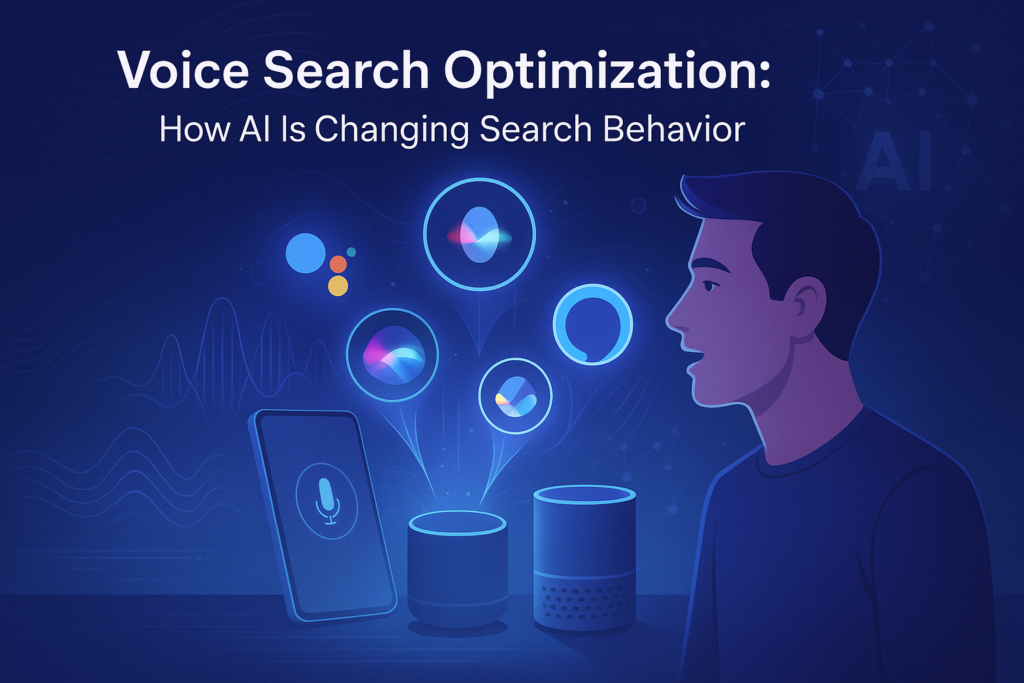Introduction: The Rise of Voice Search
“Hey Google, what’s the best SEO strategy for 2025?”
If that sounds familiar, you’re already part of the voice search revolution.
Voice Search Optimization (VSO) is the process of optimizing your website and content so that it appears in voice-based search results made through devices like Google Assistant, Siri, Alexa, or Gemini.
As more users rely on smart speakers, mobile assistants, and wearables, voice search is reshaping how we discover information. Instead of typing short keywords, people now ask natural, conversational questions — and that changes everything about SEO.
AI’s Role in Transforming Search Behavior
Artificial Intelligence (AI) is the driving force behind this massive shift. Through Natural Language Processing (NLP) and Conversational AI, search engines have become smarter at understanding human speech, intent, and context.
Here’s how AI is changing search behavior:
- From keywords to intent: AI decodes the meaning behind a query instead of just matching words.
- Context-aware responses: Voice assistants remember previous interactions to deliver better answers.
- Conversational flow: Users can follow up with questions naturally, like chatting with a human.
- Personalized experiences: AI tailors results based on location, preferences, and history.
In short, AI has made search more human, pushing SEO professionals and content creators to think beyond traditional optimization tactics.
Trends in Voice Search: How Users Interact Today
Voice search isn’t limited to smartphones anymore. It’s everywhere, from smart homes to car dashboards.
Here are the biggest trends shaping AI in search behavior:
- Smart Speakers: Devices like Amazon Echo (Alexa) and Google Nest are now household staples.
- Mobile Assistants: Siri, Google Assistant, and Gemini handle everyday queries, directions, reminders, and local searches.
- Wearables: Smartwatches and earbuds enable quick, hands-free interactions.
- Voice in Cars: Integrated systems like Android Auto and Apple CarPlay let drivers search safely without screens.
- Multimodal Search: Combining voice, text, and visual input is becoming the next big step in conversational AI.
The takeaway? Voice search is no longer futuristic, it’s the default way many users interact with technology.
SEO Strategies for Voice Search Optimization
To stay ahead in this AI-driven era, websites need to adapt their SEO strategies for voice queries. Here are actionable tips to optimize your content for voice search:
1. Focus on Conversational Keywords
People don’t talk like they type.
Instead of “best SEO tools,” they say, “What are the best SEO tools for beginners?”
👉 Use long-tail, natural language phrases that mirror how people actually speak.
2. Optimize for Featured Snippets
Most voice assistants pull answers from Google’s featured snippets.
👉 Structure your content with clear, concise answers (40–60 words) under subheadings or FAQs.
3. Improve Local SEO
Over 50% of voice searches are local, like “near me” queries.
👉 Optimize your Google Business Profile, include location-based keywords, and keep NAP (Name, Address, Phone) data consistent.
4. Ensure Mobile and Speed Optimization
Voice search users expect fast answers.
👉 Prioritize mobile-friendly design, Core Web Vitals, and page load speed.
5. Use Schema Markup
Help search engines understand your content better.
👉 Implement structured data to boost your chances of appearing in rich snippets.
6. Add an FAQ Section
Voice assistants often answer using FAQ-style responses.
👉 Create a dedicated FAQ page that includes common conversational queries.
Real-World Examples of AI-Powered Voice Search
Voice assistants are already changing how people interact with brands and content.
- Google Assistant: Uses NLP and BERT to understand intent and context for accurate results.
- Apple’s Siri: Leverages machine learning to refine responses and handle follow-up questions.
- Amazon Alexa: Integrates with businesses to provide voice commerce and personalized product suggestions.
- Gemini (by Google): Blends AI-driven conversational search with visual context, enabling multimodal experiences.
Each of these systems shows how AI is making search more conversational, contextual, and intuitive.
Future Predictions: What Voice Search Will Look Like by 2030
The future of voice search SEO will revolve around hyper-personalization and predictive intent.
By 2030, expect these major developments:
- AI-driven personalization: Voice assistants will anticipate needs before you ask.
- Emotion recognition: Systems will understand tone and sentiment.
- Omnichannel integration: Voice search will merge seamlessly across all devices and platforms.
- Conversational commerce: Shopping through voice will become mainstream.
- Zero-interface search: Screenless experiences will dominate, prioritizing spoken results.
In essence, AI and NLP in search will make interactions more human, predictive, and instant.
🔗 Internal Link Suggestions (for Codeblib)
- How to Set Up Serverless Functions in Next.js on Vercel
- Optimizing Websites for Web Vitals: A Step-by-Step Guide
- How to Improve Google PageSpeed Score with Smart Image Optimization
Conclusion: Optimize Now for the Future of Voice-Driven Search
Voice search is no longer just an SEO trend, it’s a new era of search behavior powered by AI.
For developers, marketers, and content creators, adapting now means staying visible in the age of conversational discovery.
Start by optimizing for natural language, local intent, and AI-friendly content structures.
Because by 2030, your audience might not be typing, they’ll be talking.
🚀 Optimize now for the future of voice-driven search.
